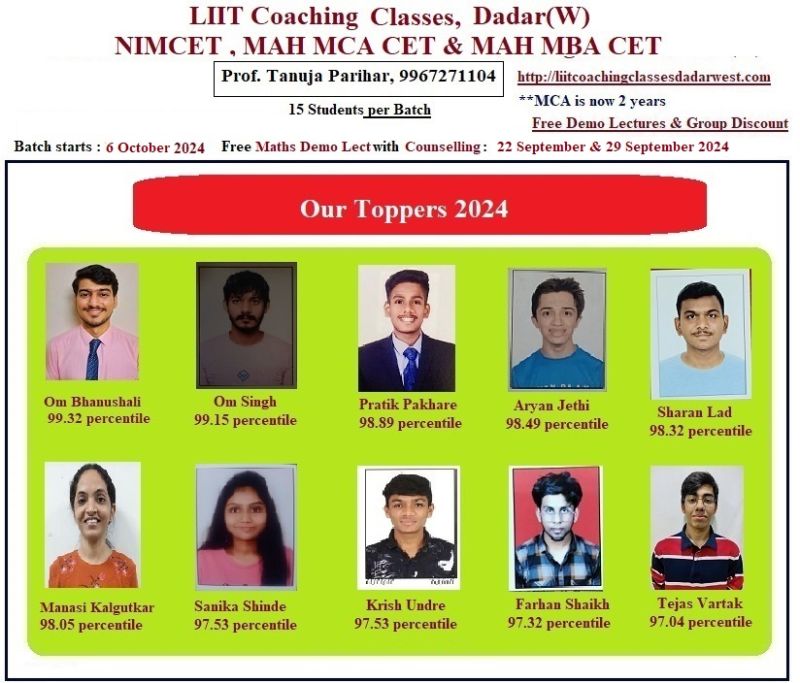
Only 15 Students per Batch
Morning Batch starts : 1 August ,4 Days per week , 6 pm to 8 pm
*Free Maths Demo Lec with Counselling Sessions : 23 July & 30 July 2024 , 5 30 pm to 7 30 pm
Fees includes
call or whatsapp
Prof Tanuja Parihar on 9967271104
Syllabus :
Total number of questions: 200 Total marks: 200 Test Duration: 150 Minutes
Multiple choice objective type questions (Five Options) No negative marking System.
Test Duration: 150 Minutes Medium of CET: English Mode of Examination - Online
Subjects :
1. Logical Reasoning 75M
2.Abstract Reasoning 25M
3.Quantitative Aptitude 50M
4.Verbal Ability/Reading Comprehension 50M
Since there is no negative marking for wrong or unattempted questions, a candidate should ensure that answers for all questions in CET are marked before the exam is concluded.
CET does not have sectional time limit. This helps CET candidates to allocate time to various sections according to their strategy.
CET does not have sectional cut offs. Hence, CET candidates have the advantage of spending more time on the section where he/she can maximise the score.
Syllabus:
Analytical Reasoning: The analytical reasoning section of CET has 75 questions. The topics covered under this section can be classified as Analytical Puzzles, Coding & Decoding, Symbols & Notations, Analytical Puzzles (Linear arrangement, Circular Arrangement, Distributions and Comparisons), Blood Relations, Direction Sense, Input – Output, Decision Making, Deductions, Critical Reasoning (Statements and Assumptions, Statements and Conclusions, Inferences – Probably true/ false, Strong and Weak argument, Courses of Action, Cause and Effect and Assertions and Reasons) and other Miscellaneous topics (Word formation, Analogies, Odd Man Out, Ranking, etc).
Abstract Reasoning: The abstract reasoning section of CET has 25 questions. In these questions a set of figures are given, and the candidates need to find logic in these pictures and answer the question. Going by the type of questions given in CET, these questions can be classified broadly as Series, Analogies, Odd Man Out, and other miscellaneous models. Series questions are again of four types – (i) Find the next figure, (ii) Find the missing figure, (iii) Find Wrong figure and (iv) Interchange of figures. Among these four, Interchange of figures were not given in the last seven eight years.
The analogy questions, based on CET pattern questions, can be further classified as
1. Four figure Analogy and Similar Pair.
In CET Odd Man Out questions are given in two different formats.
1. Odd Man Out based on individual figures and 2.Odd Pair.
Other Miscellaneous Models:
1. Paper cutting 2.Paper folding 3. Figure formation 4. Figure Completion
5.Images 6. Embedded Figures 7.Dot Situation
Verbal ability & Reading Comprehension: The Verbal Ability & Reading Comprehension section of the CET comprises 50 questions. The mode of testing on the CET is objective type questions. The CET consists of multiple-choice questions; each question has five options with no negative marking.
The Verbal Ability section of CET generally comprises two to four Reading Comprehension (RC) passages with five to seven questions per passage. The questions are based on the content of the passage and test candidates’ understanding of the passage and the vocabulary used in the context. In CET, the candidates’ ability to analyse information, assess and evaluate it, interpret the information considering the question asked, formulate a response and make the appropriate selection from the list of answer options are the key skills tested on the RC. Going by the last few years’ CET papers it is observed that the content for the passages can be from humanities, science, economics or also about some findings based on a study conducted.
The CET Verbal Ability also tests candidates’ vocabulary, the ability to understand ideas/viewpoints when presented in different ways, the ability to identify errors in sentences and select grammatically error-free, effective and concise sentences while also paying attention to the style and diction. In CET, these skills are tested across different question types such as sentence correction, sentence replacement, idea rephrase, cloze passages, idiom usages, error identification, questions based on word knowledge and words in context. The paragraph jumble questions test the logical reasoning ability as these questions ask the candidates to arrange the sentences of a jumbled paragraph in a convincing and coherent manner.
Quantitative Ability: In CET, Quantitative Aptitude is dominated by the questions from ‘Arithmetic’ and ‘Data Interpretation’ areas. It can be observed from the recent papers of CET that questions from Numbers, Time and Work, Time and Distance, Percentages, Simple Interest and Compound Interest, Averages, Partnerships, Mensuration, Probability, etc. were significantly present. Also, in CET, there were questions based on Number Series as well as Quantitative Comparison. For getting a good score in CET, one requires clarity of concepts and thorough practice of various models.
Scores of Online Examination will be obtained by adopting the following procedure:
1. Number of questions answered correctly by a candidate in each objective test is considered for arriving at the Corrected Score.
2. The Corrected Scores so obtained by a candidate are made equivalent to take care of the minor difference in difficulty level, if any, in each of the objective tests held in different sessions to arrive at the Equated Scores. (Equated Scores obtained by candidates on any test are equated to the base form by considering the distribution of scores of all the forms.)
3. Test wise scores and scores on total is reported with decimal points up to two digits.
There will be no verification of marks or revaluation of answer sheets of the CET.
Eligibility Criteria for MAH MBA/MMS CET :
To apply for MAH MBA/MMS CET, candidates must complete their bachelor's degree by attaining a minimum of 50% marks (45% for reserved category). Candidates in the final year of their UG program are also eligible to apply.